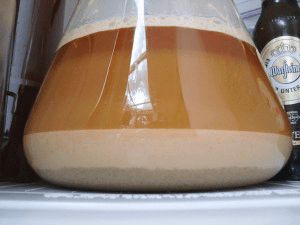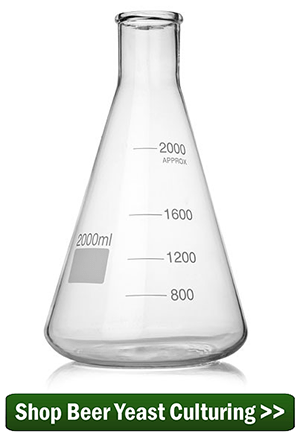 While it’s possible to pitch wort directly onto an old yeast cake, a better method of reusing yeast is called yeast rinsing. It’s a simple technique that can help make the most of your raw ingredients and keep your yeast cost down. And if you ever decide to take your homebrewing hobby to the pro level, rinsing your beer yeast will become part of your fermentation and yeast handling routine.
While it’s possible to pitch wort directly onto an old yeast cake, a better method of reusing yeast is called yeast rinsing. It’s a simple technique that can help make the most of your raw ingredients and keep your yeast cost down. And if you ever decide to take your homebrewing hobby to the pro level, rinsing your beer yeast will become part of your fermentation and yeast handling routine.
What is yeast rinsing?
Yeast rinsing is a method of taking a yeast slurry from a fermenting beer and separating the healthy, viable yeast from the dead yeast cells and trub. It’s always best to pitch as pure a yeast culture as possible, and rinsing removes much of the other particulate from the yeast slurry. This yeast can then be reused in another batch of beer. It’s best to reuse yeast from a low to moderate gravity beer after fermentation has started to slow. Yeast used in a high-gravity beer is more likely to be stressed and to produce off-flavors.
Directions For Rinsing Beer Yeast
- At the end of primary fermentation, boil 2-3 cups of water and chill it to room temperature.
- After transferring the beer into secondary, pour the pre-boiled, pre-chilled water into the primary fermenter. Swirl the fermenter to stir up the yeast at the bottom.
- Pour the slurry into a sanitized quart-size or larger glass container. A mason jar works well for this. **Remember – everything that touches the yeast at this point should be thoroughly clean and sanitized: the glass jar, the lid, and funnel (if used).
- Place the jar in the refrigerator for several hours or overnight.
- The slurry will stratify into three layers: a liquid beer layer on top, a dark layer of trub on the bottom, and a whitish layer of healthy yeast in the middle. That middle layer is what we’re after.
- Prepare another sanitized container. Pour off (decant) most of the top layer and discard, then transfer the white yeast layer into the container, leaving behind the darker trub.
That’s it! Now you can try rinsing your own beer yeast. Then you’ll be able to reuse it in a new batch of beer! I recommend using a yeast pitch calculator to estimate how much of the yeast slurry to use in your next batch.
Some pointers:
- Though professional brewers may reuse yeast for ten or more generations, I wouldn’t recommend reusing the same yeast more than 2-3 times. You can aim for more if your sanitation practices are spot on, but as soon as you notice fermentation problems, start with a fresh batch of beer yeast.
- Reusing yeast will take some foresight and planning. Chances are you won’t want to brew the exact same beer back to back, so keep the beers at least similar stylistically. That said, rinsing your beer yeast can open up some interesting cross-over experiments. For example, reuse your English ale yeast in an American IPA, or reuse your Kölsch yeast for an American cream ale.
Have you ever tried rinsing beer yeast? Why or why not?
—–
David Ackley is a writer, brewer, and craft beer marketing consultant. He holds a General Certificate in Brewing from the Institute of Brewing and Distilling and is founder of the Local Beer Blog.


Is this technique limited to beer yeast?
Jason, no it is not limited to just beer yeast. You can also do the same process with wine yeast.
from the yeast we wash, what amount of beer do we need to use? If we want to make 23 litres of beer to drink?